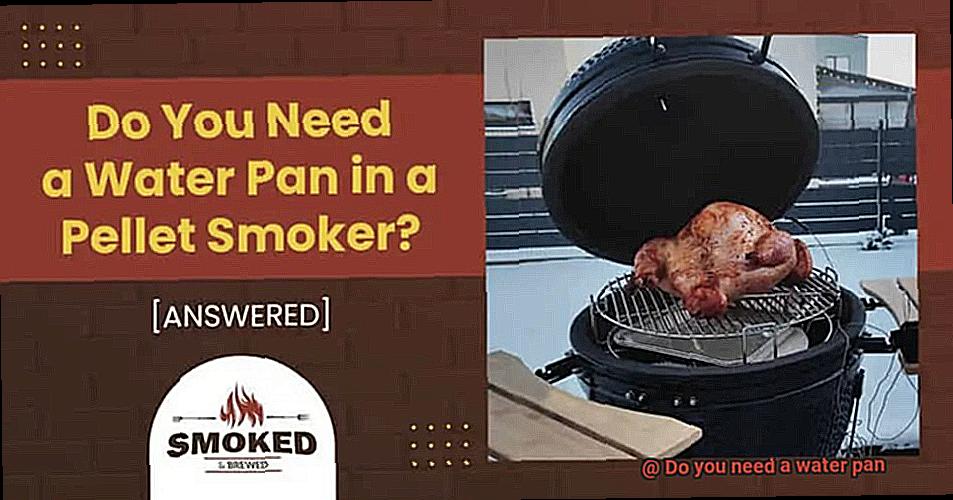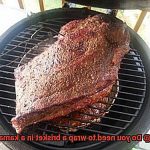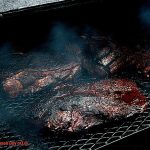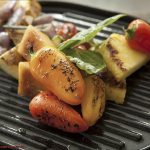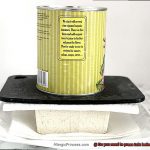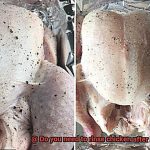Barbecue aficionados, listen up. Whether you’re a novice or a seasoned pitmaster, you’ve probably heard the age-old debate about using a water pan in your smoking process. Some swear by it, while others dismiss it as unnecessary. So, what’s the verdict? Do you really need a water pan?
Well, that depends on several factors – the type of smoker you’re using and the result you’re aiming for. While it can be an invaluable tool in certain situations, there are times when it might do more harm than good.
For those who are new to smoking, the concept of a water pan might seem baffling. Essentially, it’s a pan filled with water that is placed inside your smoker to help regulate temperature and keep your meat moist.
In this post, we’ll explore the pros and cons of using a water pan, which types of smokers benefit most from them and some tips for maintaining and utilizing one effectively. By the end of this article, you’ll have a clear idea of whether or not incorporating a water pan will take your barbecue game to the next level. Let’s dive in and discover if this is what’s been missing from your smoking setup all along.
Contents
What is a Water Pan?
A water pan is a shallow, metal tray or container filled with water that can help you achieve just that.
The water pan serves several purposes that are crucial for low and slow cooking methods. Firstly, it acts as a heat sink that helps regulate the temperature inside the grill or smoker. By absorbing and distributing heat, it creates a more stable cooking environment that prevents sudden fluctuations in temperature. This means your food will cook evenly and won’t be ruined by sudden spikes or drops in temperature.
Secondly, the water pan adds moisture to the cooking environment. As the water evaporates, it creates steam that helps keep your meat moist and tender. This is especially important when cooking tougher cuts of meat that require longer cooking times to break down the connective tissue.
Thirdly, the water pan catches any drippings or fat that may fall from your food during cooking. This not only prevents flare-ups but also reduces the risk of grease fires.
But why is moisture so important? When meat is exposed to high heat over a long period of time, it can dry out quickly. This is where the water pan comes in – by keeping moisture levels high, it helps prevent your food from becoming tough and dry.
Using a water pan is particularly useful when smoking meat or cooking something that requires a consistent temperature throughout the process. It can also be helpful when grilling larger cuts of meat, like brisket or pork shoulder.
While some grill enthusiasts argue against using a water pan, many others swear by it. Ultimately, whether or not you need a water pan depends on personal preference and what you’re grilling. If you’re grilling something quickly over high heat, it may not be necessary. But if you’re looking to achieve perfectly cooked meat with low and slow cooking methods, a water pan is an essential tool to have in your arsenal.
Benefits of Using a Water Pan
Look no further than the humble water pan – a tool every grill master should have in their arsenal. Let me tell you about the myriad benefits of using a water pan while grilling.
Firstly, regulating the temperature of your grill can be tricky, especially when cooking low and slow. But fear not, using a water pan is one of the most effective ways to achieve consistent temperature control. By placing a water pan in your grill, you create a barrier between the food and the direct heat source. This helps to reduce the temperature of your grill, making it easier to cook low and slow with less risk of overcooking.
But that’s not all – using a water pan also adds moisture to your food. As the water heats up, it creates steam which infuses into your food, keeping it moist and juicy. This is particularly important for meats like brisket or pork shoulder which can dry out quickly on the grill.
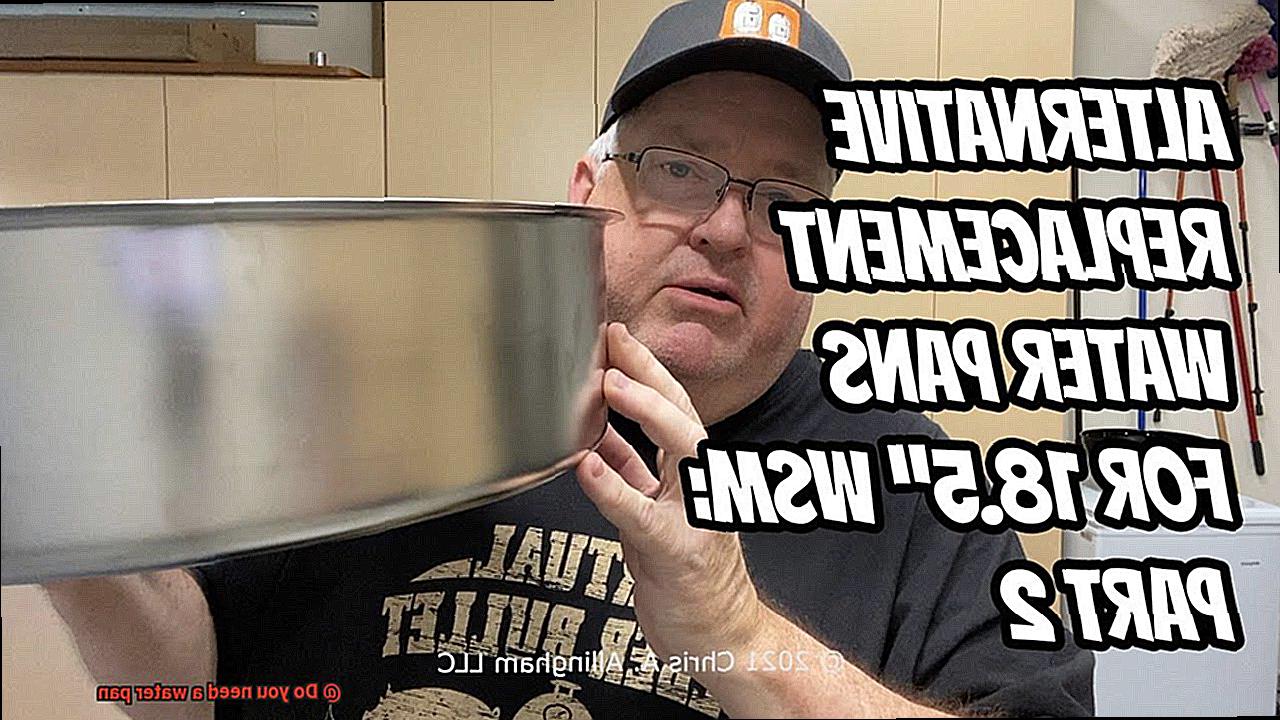
Additionally, using a water pan can help prevent flare-ups on your grill. When fat drips down from your food onto the hot coals or burners, it can cause flames to shoot up, burning your food and potentially causing a fire hazard. A water pan catches these drippings before they reach the heat source, reducing the risk of flare-ups and ensuring your food is cooked evenly.
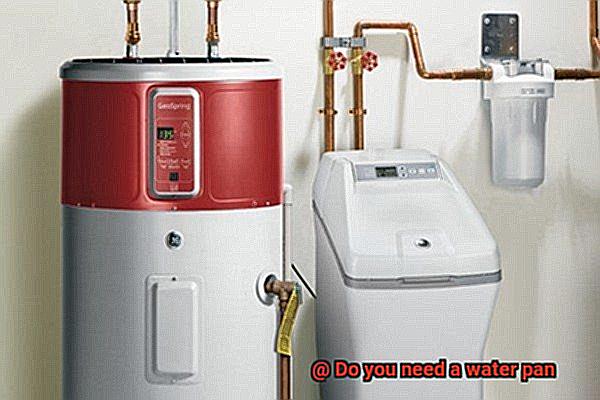
But wait, there’s more. Using a water pan also allows for endless flavor possibilities. Add herbs, spices, or even beer or wine to the water in the pan to infuse your food with delicious flavors as it cooks.
Drawbacks of Using a Water Pan
One technique that has gained popularity in recent years is the use of a water pan to regulate temperature and keep your food moist. While this approach can be effective in some cases, it’s important to be aware of the potential drawbacks that come along with it.
One major issue with using a water pan is the challenge of maintaining a consistent temperature on your grill. The water absorbs heat from the grill, which can cause fluctuations in temperature and throw off your cooking times. This can be frustrating for those who value precision in their grilling techniques and want to ensure their food is cooked evenly.
Another potential downside of using a water pan is the risk of making your food too moist. While some people love the added juiciness that comes from using a water pan, others may find that their food becomes too soggy or lacks the crispy texture they desire. Furthermore, if you’re cooking a large cut of meat like a brisket, a water pan may not be necessary since these cuts have enough fat and connective tissue to stay moist on their own.
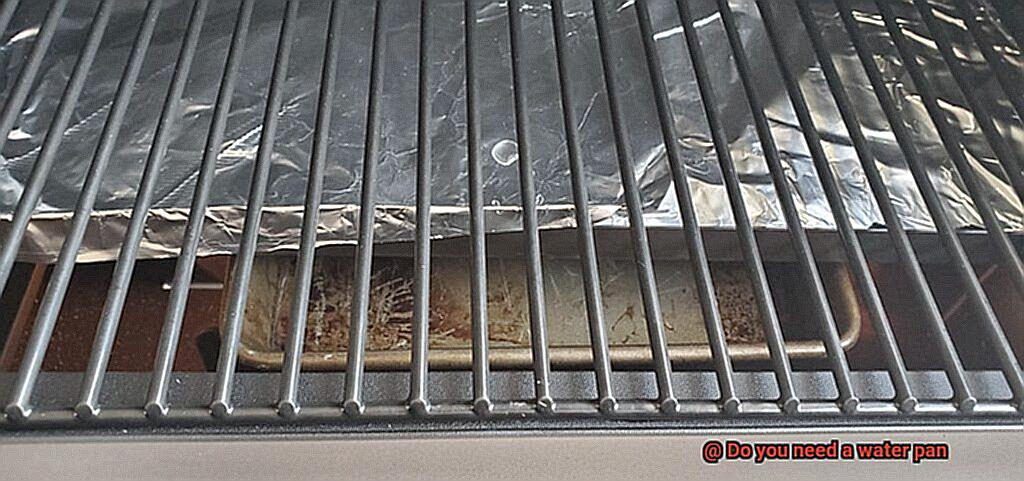
In addition, using a water pan adds an extra step to your grilling process and can be time-consuming to clean and maintain. If you’re someone who prefers simplicity and efficiency in your grilling techniques, adding a water pan may just complicate things unnecessarily.
Factors to Consider Before Deciding Whether to Use a Water Pan
Don’t make a hasty decision just yet. There are some crucial factors to consider before you decide whether to use a water pan. As an expert on this topic, I have researched and compiled a comprehensive list of things to keep in mind.
The first factor to consider is the type of meat you’ll be cooking. Certain types, such as brisket or pork shoulder, benefit from the use of a water pan to keep the meat moist during the cooking process. However, other meats, such as steaks or burgers, may not necessarily require a water pan.
The type of grill being used is another important consideration. Charcoal and pellet grills both benefit from the use of a water pan, as it can help regulate temperature and prevent flare-ups. Gas grills, on the other hand, typically have built-in mechanisms to regulate temperature and prevent flare-ups, so a water pan may not be necessary.
The size of your grill is also an important consideration. A larger grill may require a larger water pan to adequately regulate temperature and keep the meat moist. Additionally, if multiple items are being cooked at once, a larger water pan may be necessary to prevent overcrowding and ensure even cooking.
The cooking method being used is another factor to consider. Low and slow cooking methods like smoking or barbecuing benefit greatly from the use of a water pan to keep the meat moist and tender. However, high-heat grilling may not require a water pan as the meat is typically cooked quickly at high temperatures.
Finally, personal preference plays a role in whether or not to use a water pan. Some grillers prefer the taste and texture of meat cooked without a water pan, while others swear by using one for every cook.
Different Types of Grilling and How They Impact the Use of a Water Pan
Grilling is a cooking technique that involves applying high heat directly to food, and there are different types of grilling that can impact the use of a water pan. Understanding these types of grilling and their impact on the use of a water pan can help you achieve the best results for your grilled dishes.
Direct grilling is the most common type of grilling and involves cooking food directly over the heat source. This method is perfect for foods that cook quickly, such as steaks, burgers, and vegetables. When using direct grilling, a water pan is not typically necessary since the food is cooked quickly and does not require prolonged moisture. The high heat sears the surface of the food, sealing in its juices and flavor.
Indirect grilling involves cooking food next to the heat source rather than directly over it. This method is ideal for larger cuts of meat that require longer cooking times, such as ribs and brisket. When using indirect grilling, a water pan can be used to add moisture to the air and prevent the meat from drying out during the long cooking process. The water in the pan helps to regulate the temperature and creates a more humid environment, which keeps the meat tender.
Smoking is another type of grilling that involves slow-cooking food at low temperatures for an extended period using smoke from wood chips. This method is ideal for meats such as pork shoulder and brisket. When smoking meat, a water pan is often used to maintain a consistent temperature inside the smoker and add moisture to the air to prevent the meat from drying out. The water also helps to create smoke by absorbing wood chips’ energy and releasing it as steam.
Tips for Using a Water Pan Effectively
If you’re looking to elevate your grilling game, using a water pan can be a game changer. It not only helps regulate the temperature inside the grill but also adds moisture to the cooking environment. Here are some tips for using a water pan effectively to enhance the flavor and moisture of your grilled food:
Choosing the right type of pan
Opt for a pan that is large enough to hold plenty of water but shallow enough to fit comfortably on your grill. A metal pan that can withstand high temperatures is ideal.
Filling the pan with hot water
Ensure you use hot water so that it heats up quickly on the grill. Fill the pan about halfway full to ensure there is enough moisture for your food.
Monitoring the water level
Keep an eye on the water level throughout the cooking process and add more as needed. This will ensure that there is always enough moisture in the air and prevent any potential temperature spikes or burnt food.
Placing the water pan in the right location
Position the water pan directly underneath your food so that the steam can rise up and create a moist cooking environment. This will help infuse your food with added moisture and flavor.
Adding flavorings to the water
To take things up a notch, experiment with adding herbs, spices, or even beer or wine to the water for added flavor. As the water heats up and evaporates, it will infuse these flavors into your food and create a delicious aroma.
Cleaning and maintaining the water pan
After each use, make sure to wash your water pan with warm soapy water and dry it thoroughly before storing it away. This will prevent any buildup of bacteria or debris that can affect the quality of your food.
Alternatives to Using a Water Pan
Traditionally, using a water pan has been the go-to method for achieving this. However, did you know that there are alternatives that can give you similar results while also adding a burst of flavor to your dishes?
Let’s explore these exciting alternatives to using a water pan.
One option is to use a spray bottle filled with water or other liquids such as apple cider vinegar or beer. This technique involves misting the meat periodically throughout the cooking process to keep it moist. With just a few sprays, you can achieve that juicy texture we all love in our grilled meats.
Another alternative is marinating your meat prior to grilling. Not only does it help retain moisture, but it also infuses the meat with delicious flavors that will make your taste buds sing. Whether you prefer a simple marinade or something more complex, this method is sure to add an extra layer of flavor to your grilled dishes.
For those looking to add moisture and flavor during the grilling process itself, using a basting brush is an excellent option. By applying a sauce or marinade directly onto the meat during cooking, you create a flavorful glaze on the outside of the meat while keeping it moist on the inside.
Finally, placing a metal pan on the grill grates and filling it with liquid, such as broth or wine, can create steam and add moisture to the cooking process. This technique not only infuses additional flavors into the meat but also gives it that perfect texture that we all strive for.
lYRrZx1yEYg” >
Conclusion
In the world of grilling and smoking, the use of a water pan has been a debated topic among pitmasters for years. While some swear by it, others dismiss it as unnecessary. But after weighing the pros and cons, it’s clear that the effectiveness of a water pan depends on several factors.
When used correctly, a water pan can be an invaluable tool. It regulates temperature and keeps meat moist during low and slow cooking methods like smoking or barbecuing. Plus, it prevents flare-ups and opens up endless possibilities for flavor experimentation.
However, there are potential drawbacks to using a water pan. Maintaining consistent temperature control on the grill can be challenging while using one. And some may find that their food becomes too moist or lacks the crispy texture they desire.
Before deciding whether to use a water pan, consider factors such as the type of meat being cooked, the size of your grill, and your preferred cooking method. Alternatives to using a water pan include misting meat with liquid using a spray bottle or marinating prior to grilling.
Overall, incorporating a water pan into your grilling setup can take your barbecue game to the next level if used effectively. With proper maintenance and utilization techniques, you can achieve perfectly cooked meat with added moisture and flavor every time you fire up the grill.

